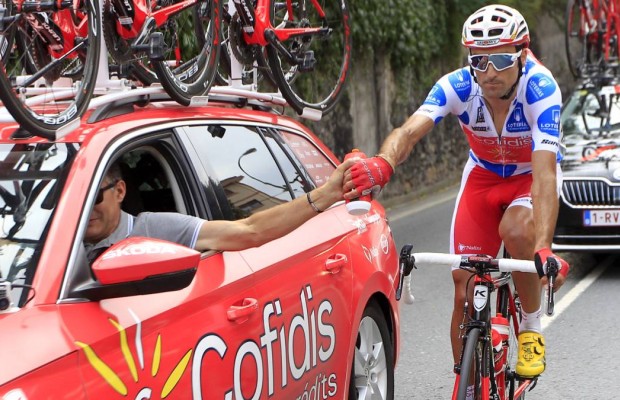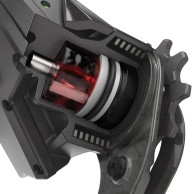Roglic and his single chainring problem
Happy ending in the Giro d'Italia for Primoz Roglic, but it could have been a tragedy if the gaps had been kept tighter, when a few kilometers from the end of the decisive time trial up Mount Lussari the Slovenian's bike chain came off in a configuration that had given rise to talk as the Jumbo-Visma rider opted for a single chainring with gravel bike gears.

Mechanics about to play a dirty trick on Primoz Roglic at the Giro d'Italia
We all know that in competition the equipment used by cyclists is pushed to the limit, either by the rough treatment given to it or by the merciless stream of watts that the bikes and their components have to withstand, much greater than what any of us can provide despite the fact that, in many cases, cyclists and competitors use the same elements.
On yesterday's day with the finish at Tre Cime di Lavaredo, Primoz Roglic changed bikes as he passed Cortina d'Ampezzo. Live we thought it was a flat tyre, but after the stage we learned that the change of machine was intentional to face the last two climbs with a bike equipped with a single chainring and a particularly short gearing, a combination with 40-tooth chainring and 10-44 cassette, what many gravel bikes usually mount, with which to climb the very hard ramps of Tre Cime di Lavaredo while maintaining a high cadence.
RECOMENDADO

How many calories are burned when cycling

What is heart rate variability and how does it affect the cyclist?

Change wheels if you want to transform your bike's behavior

What bike size do you need? Here's how to find out

How does age affect performance and recovery?

How long cyclists can be pushed when handed a sticky bottle?

In addition, yesterday's race served to test in a real situation the performance of this configuration for today's decisive time trial, with Monte Lussari as protagonist with 5 inhuman kilometers above 15%.
However, the gamble almost paid off when, a few kilometers from the finish, with the gap to Geraint Thomas extremely tight, the chain came off the chainring. Luckily Roglic didn't get nervous and was able to put it back in place and resume the ride with a minimal loss of time.
No margin for experiments
It is incredible that a group, presumably new, certainly assembled just a couple of days ago and, in the case of the team's leader, thoroughly checked, could fail like this at such a decisive moment. There are also those who criticize the team for carrying out these experiments on such a decisive day as this one.
If there's one thing we know about top-level teams, it's that they don't let themselves be pressured by the brands when it comes to using the equipment. Nothing of what we see in the race is used at random and everything is perfectly tested, either in training or during the preseason months.
It is true that this year Jumbo-Visma has made the leap from Shimano to SRAM in a strategic move by the American firm in its bitter dispute for market share against the Japanese. A change that has made their Cervélo to equip the SRAM Red AXS, the top of the range groupset of the brand that, since its launch 4 years ago, was created with versatility as a flag being valid for road, gravel or cyclocross and in configurations of dual or single chainring.
During this season we have seen the single chainring used on Jumbo-Visma bikes in more than one race, for example during the Milan-San Remo race where Wout van Aert finished third.
Possible causes
A single chainring in a new groupset, well assembled, adjusted and greased is almost impossible to get out, at least it is said not only our experience with the gravel bike but also the use of SRAM groupsets in such a brutal discipline for drivetrains as cyclocross and in which Van Aert has dominated the season with an iron fist. Although it should also be noted that in his first race with the new Cervelo cyclocross bike and the new groupsets he did suffer some problems.
The chainrings used in this configuration, not having to be designed to facilitate the movement of the chain, have a specific tooth cut with wider teeth for the wide links and narrower teeth for the narrow links, so you have to make sure that the chain is correctly positioned. If it is put in the wrong position the chain does not fully seat on the teeth and that could be one of the reasons for the problem suffered by Roglic, a mere oversight of one of the mechanics but quite unlikely in professionals who check the bikes thoroughly on a daily basis.

In addition, the SRAM Red rear derailleur has the Orbit damping system, a small hydraulic cartridge in the derailleur leg that allows smooth movements to adapt the tension when shifting up or down sprockets but almost completely prevents sudden movements caused by bumps precisely to keep the chain in place. In addition, Roglic's bike was fitted with a small chain guide to prevent the chain from slipping off to the most likely place, the inside.
Another possible reason for this chain failure is that the chain was not properly measured. If it was too long, it would not have sufficient tension, although this is also unlikely since the Slovenian was using one of the two larger sprockets at the time of the failure, so the derailleur had plenty of tension.
The most likely cause of this mechanical problem is some issue with the bike's chainline. The Cervélo R5 used by Jumbo-Visma riders on mountain stages, like all Cervélo bikes, has the specific BBRight bottom bracket system, an asymmetrical design in which the brand widens the bottom bracket to the left side only. This allows them to widen the bottom bracket shell for greater stiffness while keeping the cranks very close to the frame on the right side to keep the Q factor as low as possible.

In the description of this bike in the information available from Cervélo, it is not mentioned at any time that the bike is compatible with single chainring configurations, unlike many current models. Although the differences in the position of the chain line are subtle, just a few millimeters, they may be enough for the chain, in extreme positions, to come off the chainring.
Finally, we must not forget that there is no such thing as a 100% perfect functioning of the groupsets. Everything has a margin of failure and maybe we are making conjectures about the configuration made by Jumbo-Visma when surely they have tested this option to the limit before deciding to use it in competition and it was simply a matter of bad luck that the chain came off just today, at the most inopportune moment.
The single chainring on the road
Although the mechanical simplicity of the single chainring in any discipline would lead one to believe that it would be a matter of time before it would be implemented on the road, as has happened in MTB, where it is already the majority option, or Gravel on the road, things are more complicated.

Five years ago the Continental AquaBlue team was forced to race with a single chainring because they were using the Strada aerodynamic road bike model created by 3T that only accepted this configuration. The problem with using a single chainring on the road every day is that it forced riders to choose between having enough range at both ends to cover all needs or keeping a jump between gears that didn't hurt the legs.
An aspect that was aggravated by the fact that, at that time, the groupsets were still 11-speed and SRAM did not yet have cassettes with 10-tooth sprockets for the road.

With the arrival of the 12-speed and the SRAM Red AXS the aspect of the progressiveness of the development jumps and the range between extremes has been improved although it is still too much for a road professional who has to carry the exact development for each specific race situation to optimize each effort. However, it is a valid option for races such as Milan-San Remo or Paris-Roubaix where the riders do not remove the big chainring all day, precisely in these races is where we have seen its use.
However, we had not yet seen him in decisive mountain stages as Roglic has done in the last two stages of this Giro d'Italia looking for a super short development to face extreme slopes.